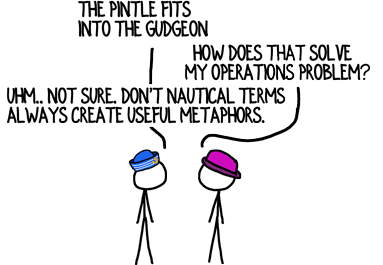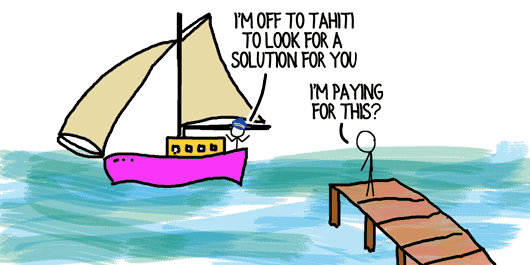There you are, polishing the sign in front of your catamaran and trying to attract consulting projects from the throngs of prospects meandering along the oceanfront. A boat-owner on the adjacent pier hails you: “Would you like to join forces? I’m sure we could catch more consulting clients together.” What do you think? Will adding more boats to your armada result in more clients?
Take a moment to look at the reality and rules of partnering.
(Note: This article was published in slightly different form in 2015. In the intervening years, I’ve obtained no new nautical knowledge, nor any greater misgivings about grossly overextending a metaphor.)
Reality: Prospects who want berths on ocean liners won’t choose
your skiff, even if it’s tied to a handful of others.
Many boutique consulting firms consider partnering to make themselves more attractive to buyers who lean toward big-name consultancies. “Companies don’t want a small shop like mine,” they reason. “Adding a confederate or two will make me a viable option for more projects.”
But heading in this direction misjudges the currents. Most prospects who will seriously consider a 50-person consulting firm will also hire a 15-person consulting firm, a five-person shop or even a solo practitioner.
In contrast, decision-makers who dismiss single-shingle consultants out of hand typically express equal disinterest in boutiques and loose networks of small players.
Don’t fool yourself into thinking a partner or two will convince a prospect to jump ship from his Crystal Cruises mega-steamer. You’re a different type of vessel, period. Take on the clients who appreciate your sleek lines.
That isn’t to say partnering will always leave you high and dry. Quite the opposite. The right partnerships will buoy your consulting firm. Which is why you should navigate the shoals of collaboration with the following three rules in mind:
Rule #1: Only Add Sails That Capture More Wind
Unless a partner can reach prospects that you can’t touch already, they’re not adding value in terms of business development. Overlapping networks do nothing other than steal wind from each other’s sails and cause confusion over who gets credit for propelling the ship.
Rule #2: Your Partner Must Instinctively Duck When You Jibe
Let’s be frank: not everyone works well with others. Some well-intentioned souls are so frustrating, they make you want to scuttle your own ship. Others who like the cut of your jib make reasonable mates; but reasonable isn’t good enough for partnering. Give them a wide berth too.
Only a precious few share your definition of the North Star and work with you like an America’s Cup crew. Those are the only consultants you should consider as partners.
Rule #3: Join Forces When a Catch is in Sight
The greatest white lie among consulting firms is, “When I see an opportunity that looks right for you, I’ll definitely send it your way.” Consultants are well-meaning, but promises to help each other are worth their weight in vapor.
Far too many small consulting firms and solo shops are building loose coalitions with the naïve hope that colleagues will produce hot, leviathan-sized leads.
Save your partnering energy for those times when a concrete opportunity is well-defined and you can steer toward it immediately.
Partnerships should play an important role in your consulting firm’s go-to-market plan. Particularly partners who can reach multitudes of prospects on distant shores or who can provide much-needed manpower and skills.
However, remember that multiple boats tethered together don’t travel faster. Most often, they just get tangled up until they cast off the linkages and drift apart.
Use the reality and rules above as your anchor, and you’ll weather the stormy seas of small-firm consulting better than you’d think.
What other rules have worked for you in partnerships with colleagues?
Text and images are © 2024 David A. Fields, all rights reserved.

 David A. Fields Consulting Group
David A. Fields Consulting Group 



Amen brother! “After all is said and done, more is said than done.” –Aesop
That Aesop was as cunning as a fox. As you’re highlighting, unless the partnership produces tangible results, it’s just talk. Thanks for noting that, Doc!
David – some great guidance, as always. I’d add that transparency builds trust. (I’ll leave the boating metaphors to you.) Over-explaining or making some big pretense about the relationship between the partners creates the potential for more questions than answers. Give the client confidence that this is the best team for the job. Period.
Exactly right, Jonathan. Falsely claiming to clients and prospects that your firm is larger than it is will ultimately do you no favors. These days, the type of clients who will hire your consultancy are perfectly aware of (and fine with) virtual firms.
Great addition to the article, Jonathan.
Love this – and makes so much more sense having been round the block a few times with those well intentioned ‘partner for the future…’ blind alley conversations.
Defining the North Star is a nice way to test for alignment. We’re also doing a lot with ‘Pirate Codes’ right now – agreeing a handful of deeply-help principals by which to collaborate, and develop a relationship.
#bemorepirate and so relevant now with the rise of the freelancer and more people opting out of the big corporate world for a better life/work experience
Having a clear set of principles for your firm–and for working with partners–will definitely help you succeed.
Thanks for sharing the great idea, Ben!
David, I have learned a couple of lessons over the years in my attempts at partnering with other consulting firms. My most difficult lesson was in partnering with someone who on the surface it appeared that we shared the same philosophy, when in practice we did not. I learned that I should only partner with others who will promote who I am as a person rather than to force fit my authentic self into someone I am not.
Wise words borne of painful experience. As the leader of your consulting practice (or, perhaps, as a solo practice), every client and partner you take on must mesh with who you are, or you’re going to suffer through many unenjoyable days.
I’m glad you shared your wisdom with me and other readers, Kay.
Excellent & Agreed with the comments.
I appreciate the feedback and support, Peter!